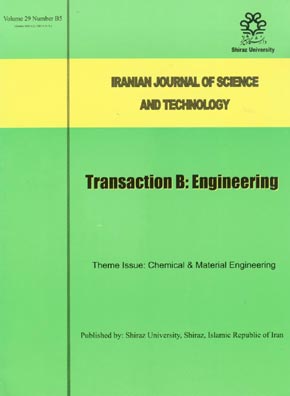فهرست مطالب

Iranian Journal of science and Technology (B: Engineering)
Volume:29 Issue: 5, October 2005
- Chemical & Petroleum Engineering
- 68 صفحه،
- تاریخ انتشار: 1384/10/10
- تعداد عناوین: 5
-
-
Application of the Taguchi method to optimize the process conditions in the production of lipase by Pseudomonas aeruginosa B-3556Page 475Pseudomonas aeoroginosa B-3556 was grown on soy flour based semi-solid media for lipase production. The effect of different factors including medium composition, pH, temperature, mixing intensity and substrate particle size on lipase productivity was analyzed using the Taguchi method in three steps. Based on these analyses the optimum concentrations of soy flour, (NH4)2HPO4, K2HPO4 and MgS04.7H2O were found to be 3%, 3%, 0.5% and 0.21% respectively. Furthermore, optimum values for temperature, pH and the shaking speed were determined as 30 °C, 7.1 and 150 rpm. As for the substrate particle size, the best result was achieved when the soy flour had a mesh size cut of 60-70. The influence of the trace elements on lipase production was studied and it was shown that their addition to the medium was not necessary. Maximum lipase activity under optimum conditions was obtained as 44.8 unit/ml after 48 hrs of cell cultivation.
-
The dynamic modeling of the pressurizer surge tank transients in the light water reactor nuclear power plantsPage 483The surge tank is equipped with a spray and relief system as well as electric heating elements. The pressure is controlled by the increase in bubble populations through heating and / or flashing or steam condensation through water sprays.This paper analyses the transient behavior of the surge tank in a WWER type pressurized water nuclear power plant. An analytical method is developed for predicting pressure and water level variations in the surge tank following in or out surge processes. The analysis also takes into consideration the variation of the thermodynamic mass qualities inside the surge tank. The results obtained are compared with RELAP5/Mod3 and RELAP5/Mod2 as valid codes. D’Auria’s model (FFT method) is employed for this comparative analysis.
-
An experimental investigation of the effect of random g-jitter on a liquid-bridgePage 493Marangoni convection experiments have been conducted with 5 cSt silicone oil liquid bridges to investigate the effect of random g-jitter on the transition from steady to oscillatory convection at various aspect ratios in a half floating zone. A liquid bridge of 5 cSt silicone oil was suspended between two circular-coaxial disks both 7 mm in diameter and placed on a moving table which produced random g-jitter in all three directions. The g-jitter produced by the table was less than 12 mg simulating the g-jitter in the spacecraft enviroment. The effect of g-jitter was studied on critical temperature difference for different aspect ratios. It was concluded that g-jitter does not change the critical temperature difference in a half floating zone.
-
A new and a simple model for surface tension prediction of water and organic liquid mixturesPage 501In this paper a new simple equation for surface tension prediction of binary aqueous-organic solutions over the entire range of compositions is presented and used for the calculation of surface tension of 15 binary aqueous-organic solutions. The overall average absolute deviation is 0.53%. The parameters of the new equation are calculated for the binary systems under study and it is shown that in the temperature range used for surface tension calculations they are independent of temperature and can be expressed in terms of the normal boiling point of organic compounds.
-
Mathematical and computational modeling of mold filling and heat transfer in metal castingPage 511In the present study a finite difference method has been developed to model transient fluid flow and heat transfer in metal casting. A single fluid has been selected for modeling the mold filling and the SOLA VOF 3D technique was modified to increase the accuracy and speed of simulation of filling phenomena for shape castings. The model was then evaluated with the experimental methods. Referring to the experimental and simulation results, a good consistency and accuracy of the suggested model are observed.

